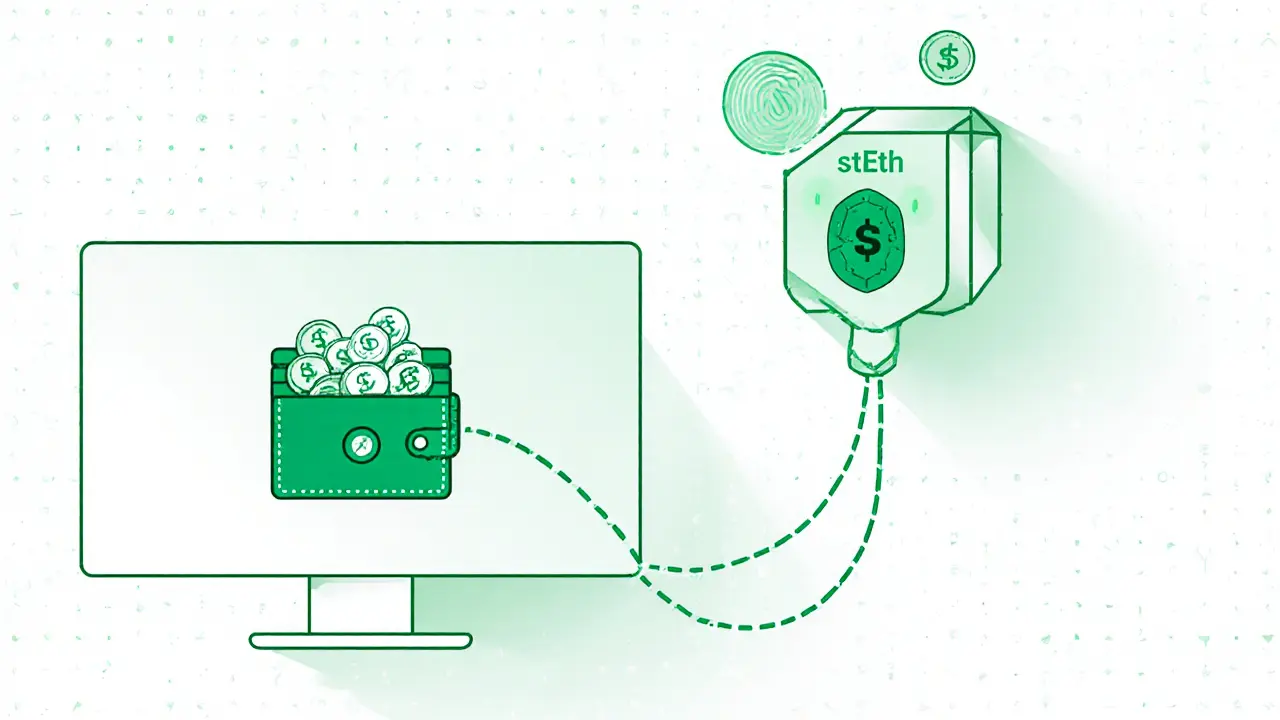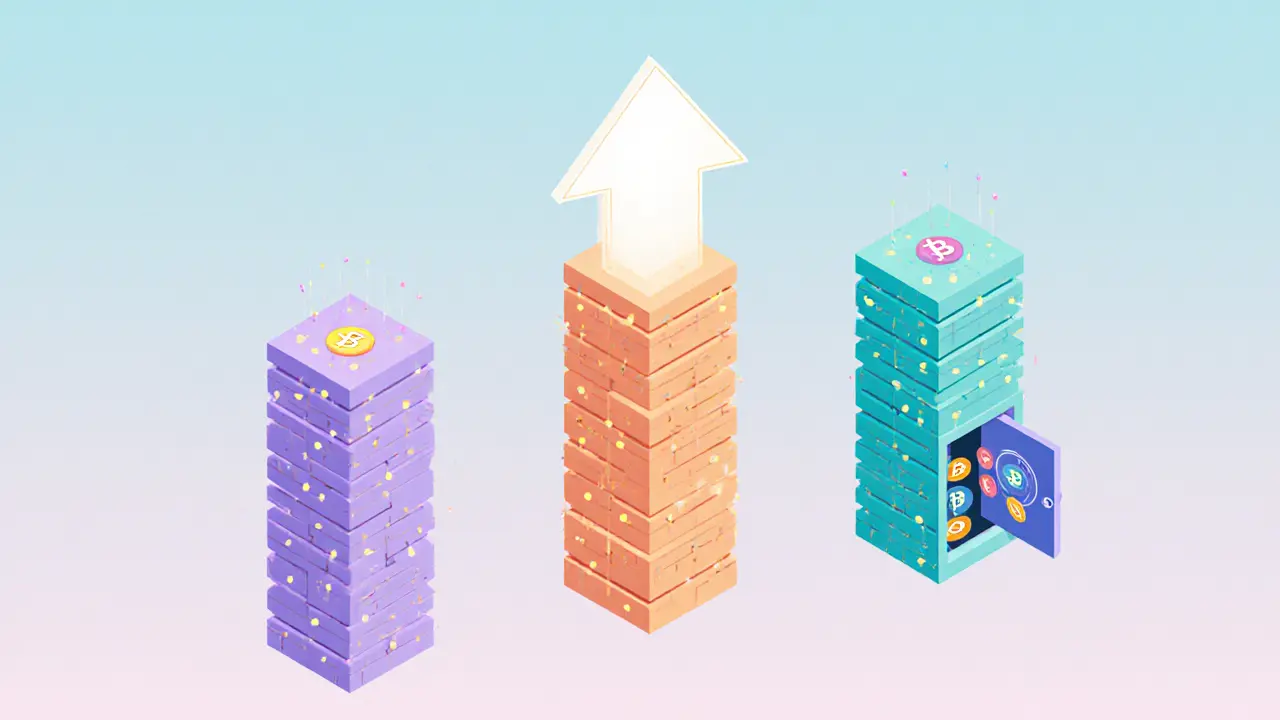Crypto Staking Guide: How to Earn Rewards in 2025
 May, 5 2025
May, 5 2025
Crypto Staking Rewards Calculator
Estimate Your Staking Returns
Calculate potential rewards based on your investment, APY, and time period. This tool helps you compare different staking options.
Input Parameters
Your Estimated Returns
Staking Method Comparison
| Staking Method | Typical APY | Minimum Deposit | Risk Level |
|---|---|---|---|
| Centralized Exchange | 3-7% | As low as 0.01 ETH | High Risk |
| Staking Pool | 8-12% | 1-5 DOT | Medium Risk |
| Decentralized Platform | 4-6% | 0.1 ETH | Medium-Low Risk |
| Run Your Own Validator | 5-10% | 32 ETH | Low to High Risk |
Understanding Your Results
These calculations are estimates based on current APY rates. Actual returns may vary due to network changes, market fluctuations, and protocol updates.
Looking to turn idle crypto into a steady stream of income? Crypto staking lets you lock up tokens, help secure a network, and collect extra coins as a reward. Below is a no‑fluff walk‑through that shows you exactly how to start, what tools you need, and which pitfalls to dodge.
What Is Crypto Staking?
Crypto staking is a process where token holders lock their assets in a proof‑of‑stake (PoS) blockchain to earn rewards. The network uses those locked tokens to validate transactions, and in return it mints new coins for the participants. Unlike Bitcoin's energy‑hungry mining, staking runs on a simple algorithm that picks validators based on how much they have staked.
How Staking Works - Five Core Steps
- Pick a PoS coin. Only blockchains that use proof‑of‑stake or a variant (e.g., delegated proof‑of‑stake) can be staked. Popular options include Ethereum, Polkadot, Cardano, and Solana.
- Buy the coin. Purchase the token on an exchange or move it from a wallet you already own.
- Choose a staking method. You can stake directly on the blockchain, join a staking pool, or use a centralized exchange.
- Lock the tokens. Follow the platform’s instructions to lock your coins for the chosen period.
- Collect rewards. Rewards are paid automatically-usually daily, weekly, or monthly-based on the network’s APY.
Staking Methods Compared
| Method | Control of Private Keys | Minimum Deposit | Typical APY | Risk Level |
|---|---|---|---|---|
| Centralized Exchange (e.g., Kraken, Coinbase) | No - exchange holds keys | As low as 0.01 ETH | 3‑7 % | High (exchange hacks, fund freezes) |
| Staking Pool (e.g., Polkadot pool) | Yes - you keep your wallet | 1‑5 DOT | 8‑12 % | Medium (pool operator reliability) |
| Decentralized Platform (e.g., Lido for ETH) | Yes | 0.1 ETH | 4‑6 % | Medium‑Low (smart‑contract bugs) |
| Run Your Own Validator | Yes (full control) | 32 ETH (or equivalent) | 5‑10 % (varies by network) | Low to High (requires technical upkeep, slashing) |
Choosing the Right Platform
Three questions can narrow your choice in seconds:
- Do you want full control of your keys? If yes, avoid centralized exchanges.
- How much capital can you commit? A full validator needs a hefty sum, while pools and exchanges accept tiny amounts.
- Are you comfortable with technical risk? Running a validator carries slashing penalties if your node goes offline.
For most beginners, a reputable exchange like Kraken offers a one‑click experience and a transparent fee schedule. If you can handle a slightly steeper learning curve, a staking pool such as the Polkadot community pool gives you better yields while keeping custody of your tokens.

Step‑by‑Step Example: Staking ETH on a Decentralized Platform
Let’s walk through a real‑world scenario using Lido, a popular liquid‑staking service.
- Install a self‑custodial wallet like MetaMask and fund it with at least 0.1 ETH.
- Navigate to the Lido app (lido.fi) and connect your wallet.
- Enter the amount of ETH you wish to stake and confirm the transaction. Lido will lock your ETH in a smart contract.
- Immediately receive stETH tokens that represent your share of the staking pool. You can trade, lend, or hold these tokens while you earn rewards.
- Check the “Rewards” tab weekly. Lido automatically compounds the earnings, so your stETH balance grows without any action on your part.
The whole process takes about ten minutes, and you stay in control of the original private key.
Understanding Rewards and Tax Implications
Rewards are usually paid in the same coin you staked, but some platforms issue a “receipt” token (like stETH). The reward rate fluctuates with network demand, so the advertised APY is a projection, not a guarantee.
From a tax perspective, most jurisdictions treat staking income as ordinary income at the moment it’s received, then as capital gains when you sell the rewarded tokens. Keeping detailed logs-date, amount, and fair‑market value-will save you headaches during tax season.
Common Risks and How to Mitigate Them
- Exchange custody risk. Keep only a small portion of your portfolio on centralized exchanges. Use hardware wallets for the bulk of your holdings.
- Slashing. If you run a validator, monitor uptime closely. Choose well‑reviewed infrastructure providers if you outsource the node.
- Smart‑contract bugs. Stick to audited platforms (Lido, Rocket Pool) and watch for community reports before depositing large sums.
- Liquidity lock‑ups. Some pools impose a waiting period before you can withdraw. Factor this into your cash‑flow planning.

Tips for Maximizing Your Staking Yield
- Diversify across at least two networks (e.g., Ethereum + Polkadot) to spread protocol risk.
- Reinvest rewards (compound) rather than cashing out each payout.
- Monitor network upgrades; a hard fork can temporarily boost or cut rewards.
- Use platforms with low fees. For instance, Lido charges ~10 % of the reward, while some pools only take 2‑3 %.
Future Outlook - What to Expect in the Next Few Years
Staking is set to become a mainstream feature on most crypto wallets. Expect lower minimum deposits, zero lock‑up periods, and built‑in risk dashboards that flag slashing threats. Institutional players are already offering staking‑as‑a‑service, so retail users will soon have access to bank‑grade custody combined with PoS yields.
Key Takeaways
- Staking converts idle crypto into passive income while supporting network security.
- Choose a method that matches your risk tolerance: exchanges for ease, pools for balance, validators for maximum control.
- Keep your private keys safe, track rewards for tax purposes, and avoid putting all eggs in one basket.
- Reinvest rewards and diversify across multiple PoS chains to boost long‑term returns.
Can I stake Bitcoin?
No. Bitcoin uses proof‑of‑work, which relies on mining hardware, not staking. You can only stake coins that run on a proof‑of‑stake consensus.
What’s the difference between a staking pool and a validator?
A validator is an individual node that directly secures the network and can be slashed for misbehaving. A staking pool aggregates many small holders and delegates the voting power to a professional validator, sharing the rewards proportionally.
Do I need to lock my tokens forever?
Lock‑up periods vary. Centralized exchanges often let you unstake instantly, while some native blockchains (like Cosmos) require a 21‑day unbonding period. Always check the specific protocol rules.
How are staking rewards taxed?
In most countries, rewards are treated as ordinary income when received. If you later sell the rewarded tokens, you incur capital‑gains tax on any price increase.
Is staking safe for beginners?
Yes, if you start with a reputable exchange or a well‑audited pool and keep the stake amount small. Grow your exposure only after you understand the risks.
Wayne Overton
October 25, 2025 AT 03:44Staking is just crypto pyramid scheme with better branding
Alisa Rosner
October 25, 2025 AT 06:29OMG YES!! 🙌 Staking is LIFE CHANGING 💸 Just staked 0.5 ETH on Lido and got 0.008 in rewards this week!! 🎉 You can literally sleep and earn!! 💤✨ Don't overthink it-just start small and watch it grow!! 💪❤️
MICHELLE SANTOYO
October 26, 2025 AT 02:02So you're telling me we're now paying people to hold money instead of making anything? This isn't finance-it's a metaphysical illusion wrapped in blockchain glitter. The real wealth was always in the soil, the sweat, the real labor. Now we're just hypnotized by decimal points and glowing graphs. Wake up.
Lena Novikova
October 26, 2025 AT 18:09Everyone's acting like staking is magic but the truth is exchanges control everything anyway. If Coinbase freezes your account you're screwed. And APYs are just marketing lies. The real yield is in the fees they charge you to even access your own money. Stop being fooled
Olav Hans-Ols
October 27, 2025 AT 08:12Really appreciate this guide-clear, no fluff, just the facts. I started with 0.1 ETH on Lido last month and it's been smooth sailing. The stETH tokens are legit, and I like that I can still use them in DeFi. Keep it up!
Kevin Johnston
October 27, 2025 AT 15:17Staking = free money 🚀💰 Just do it!!
Dr. Monica Ellis-Blied
October 28, 2025 AT 01:36While the mechanics of staking are technically sound, one must consider the systemic risk inherent in centralized intermediaries-particularly when custody is relinquished. Furthermore, the tax treatment of staking rewards remains legally ambiguous across jurisdictions, and failure to document fair market value at time of receipt constitutes a material compliance risk. I urge all participants to consult a licensed tax advisor before engaging.
Herbert Ruiz
October 28, 2025 AT 20:48Why are you recommending Lido? It's been audited once. And the 10% fee is ridiculous. You're better off just holding.
Saurav Deshpande
October 29, 2025 AT 07:33They want you to stake so they can track every move. The blockchain isn't decentralized-it's a surveillance tool for the Fed. Soon they'll freeze your staked ETH if you criticize the government. This isn't finance. It's social credit with crypto branding.
Paul Lyman
October 29, 2025 AT 18:12Just staked my first 0.3 SOL on a pool and it's been amazing!! Rewards come every day and I didn't even have to do anything!! Seriously guys if you're on the fence just try it with a small amount you won't regret it!! 💪🔥